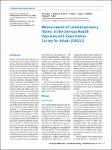Measurement of cardiorespiratory fitness in the German Health Interview and Examination Survey for Adults (DEGS1)
Finger, Jonas
Gößwald, Antje
Härtel, Sascha
Müters, Stephan
Krug, Susanne
Hölling, Heike
Kuhnert, Ronny
Bös, Klaus
A state of good fitness is related to a better health state and a lower mortality risk. In the German Health Interview and Examination Survey for Adults (DEGS1), aerobic fitness was measured among adults between 18 and 64 years old using a submaximal cycle ergometry test. The total sample comprised 5,263 persons, amongst those 3,111 were categorized as being test-qualified according to the Physical Activity Readiness–Questionnaire. There were 3,030 persons who absolved a submaximal exercise test according to the exercise protocol of the WHO (25/25/2). The test-participation rate was 57.2% in relation to the total sample and 97.4% among test-qualified persons. Apart from the continuous heart-rate monitoring, capillary blood was taken prior to starting the test and at the end of each workload stage for performing blood lactate analyses. The test ended when 85% of the age-predicted maximal heart rate was exceeded. In all 11.9% of the tests were terminated earlier, the mean exercise duration was 10.8 min, and the anticipated submaximal exertion in the highest workload stage was on average achieved with a mean of 15 on the 20-point RPE scale. The nationwide data can now be used for the national health monitoring system, epidemiological research and for the calculation of reference values.
No license information

